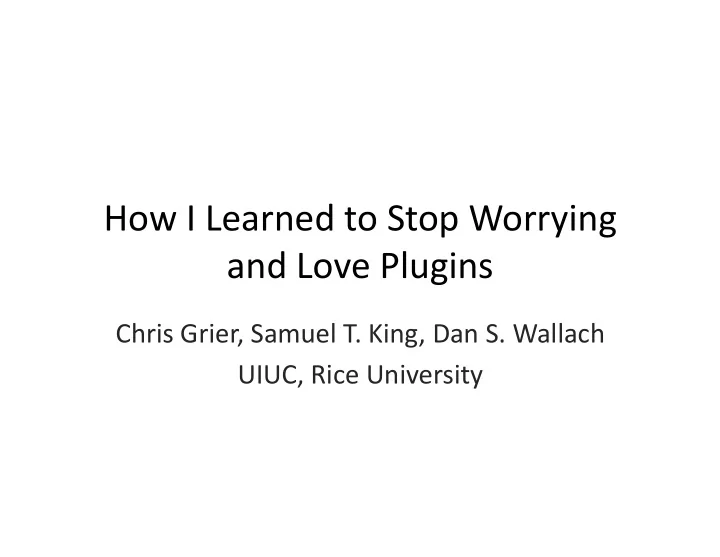

How I Learned to Stop Worrying and Love Plugins Chris Grier, Samuel T. King, Dan S. Wallach UIUC, Rice University
Browser Plugins • Plugins enable new types of content to be displayed by browsers • Rich media, interacGvity • Last year 419 disclosed plugin vulnerabiliGes – Acrobat, Flash, Java, etc… • Plugins can provide a direct means to take over computer systems – 99% of Internet users have at least one plugin installed 2
3
Tuesday news Flash, Acrobat vulnerabiliGes used for drive‐by download CERT release says malware redirects Google search results 4
5
• hVp://www.flickr.com/photos/24967759@N00/2924995732/ 6
Current state of the art • FF/IE8 – No control over plugins – AcGveX sGll poses substanGal security risks • Chrome, OP, Gazelle – Plugins isolated from browser – OP/Gazelle ‐‐ plugins use browser kernel – Chrome supports using sandbox for plugins – What policies to enforce? 7
Plugin policies • What plugin policies should we use? • Start looking at tradeoffs with security vs. funcGonality and compaGbility 8
Outline • Browser and plugin architectures • Plugin capabiliGes • Proposed policies • Preliminary Flash study 9
IsolaGng plugins Separate protecGon domains • Plugin in a sandbox – Required to use browser – Prevent system damage • Browser handles plugin access • Possible sandboxes include – NaCl, OS‐level sandboxes, others 10
Benefits of using browser • Browser has semanGc informaGon from parsing page – Can use HTML aVributes, tags • Users have a single place for configuraGon of security policy 11
Plugin capabiliGes • DOM • Network • Storage • Devices 12
Proposed policies • Goal: Determine acceptable policies for plugins • Policy for each of the different areas of access • The mechanism exists, we need to develop policies that are reasonable – Allow funcGonality – Use browser to enforce security • Many possibiliGes, more detail in paper 13
Document access • Rooted subtree – Web page author specifies an element for plugin – Plugin has access to the element, can modify subtree • Clean document – Provide the plugin with access to the tags and structure – Remove text, aVributes 14
Persistent state • Jailed access – Filesystem is accessed through chroot type jails • AutomaGc – Determine global vs. local state automaGcally – ParGGon the plugins accesses 15
Network access • Same‐company – Origin too fine, should abstract to handle popular use like content delivery networks – DNS lookups provide hints for domain ownership • All‐or‐one – Plugins can choose: any network access or local system access but not both 16
Device access • Don’t let plugins determine access on their own – Page, user, and plugin can provide hints • CapabiliGes – Page defines a set of capabiliGes a plugin can request, browser policy can be more or less restricGve – Embedding an ad? No device access. – Embedding a game? Sound playback only. 17
What to fix first • A quick look at what Flash does online • Minimize impact on backwards compaGbility ‐ get the mechanisms and policy in place. • Download random SWFs, decode and inspect which APIs are used – Networking/Socket: 68% – ExternalInterface, LocalConnecGon: 1% – FileReference: <1% – Media APIs for camera/mic access: 2% – Shared objects (flash cookies): 2% 18
Conclusion • Plugins significantly enhance the web experience – Adds great funcGonality – With significant security problems • Browser controls can enable security without losing funcGonality • Commercial and research browsers have mechanisms but we need good policies 19
QuesGons? 20
Specific Flash use • AdverGsement (MS Flash ad on Facebook) – No network, filesystem, document – Sound device opened • Game (Pandemic 2) – No document, fs access – Plays sound, opens new tabs for web pages • Video (Hulu) – Stores sepngs using flash cookies – Fetches video content with networking API – No document access – Full‐screen, video and sound 21
Recommend
More recommend